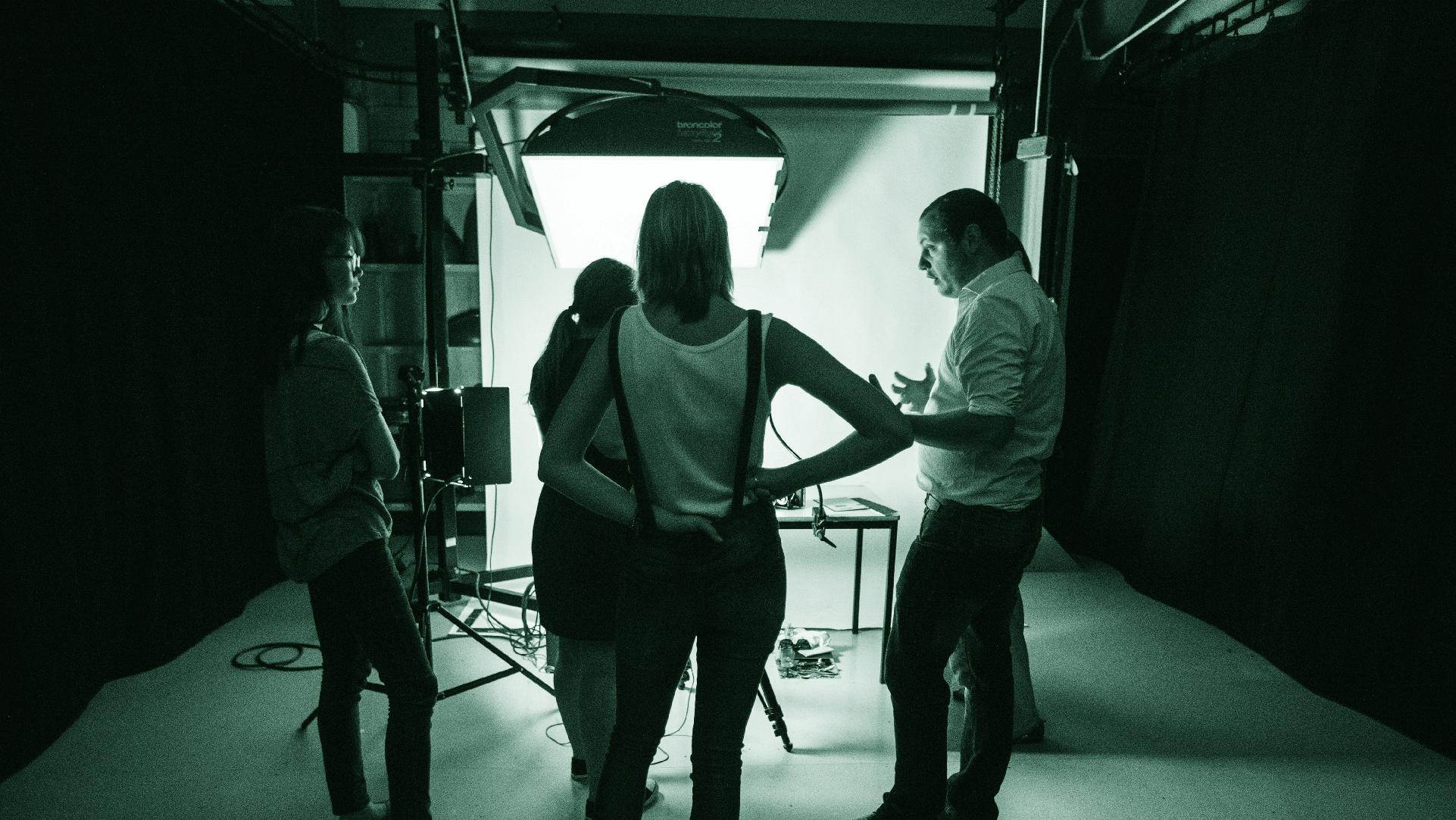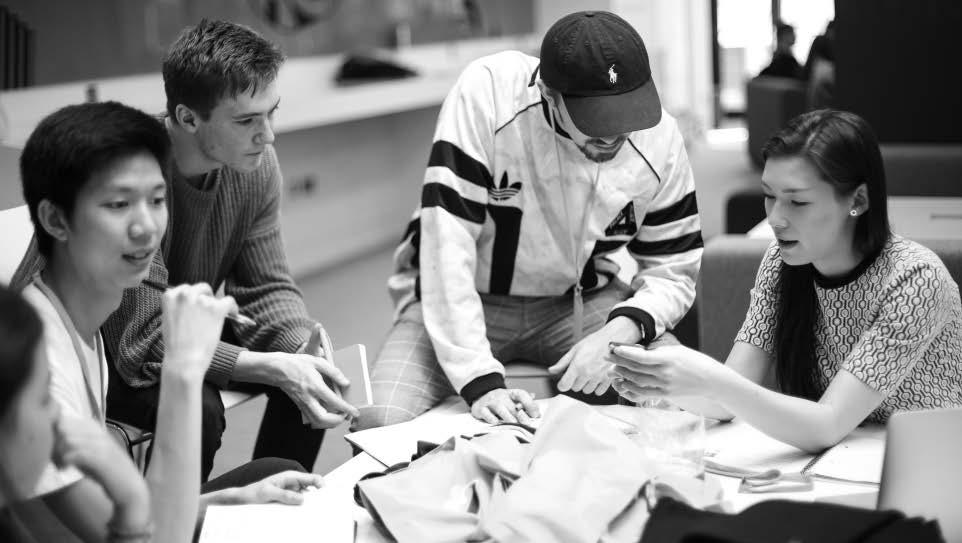Graduate Futures Frame work
Creativity
Specialist technical skills
Creative thinking
Aesthetic skills
Cultural awareness
Excellence
Critical thinking
Resilience
Adaptability
Confidence
AUB values
Innovative Passionate Collaborative Connected
Relevance
Problem solving
Inclusive of diversity
Global citizenship
Ethical
Impact
Digital and visual literacy
Project management
Professionalism
Communication and interaction
As a specialist arts university one of our strategic goals is to create opportunity for our students, alumni and staff through a passionate belief in collaboration, creativity and innovative practice. We want to ensure that AUB graduates build on our AUB values and graduate attributes, developing meaningful careers and making a positive impact on society.
AUB values and graduate attributes:
Employability is defined as “a set of achievements – skills, understandings and personal attributes that make graduates more likely to gain employment and be successful in their chosen occupations, which benefits themselves, the workforce, the community and the economy” (Yorke, 2004)
Through an innovative, rigorous and inclusive curriculum informed by current industry practice, students will have every opportunity to develop the skills and attributes necessary to find highly skilled post-graduation.
Key Aims:

• To ensure that the proportion of AUB graduates in highly skilled employment exceeds the OfS benchmark of 67.5%
• To embed industry partnered learning into all AUB courses.
• To increase the number of embryonic businesses at AUB.
1. Ensuring all courses are relevant, current and informed by industry practice.
1a. Enhanced relevant curriculum:
• We will ensure that all students engage in industry partnered learning or work-based practice.
1b. External Representation:
• We will ensure that every course is linked with an Industry Patron.
Targets:
1. AUB Industry patrons work with AUB academics to co-create the curricula to promote graduate recruitment and provide networking opportunities between students and potential employers
2. Industry patrons will attend a minimum of two industry patron group meetings plus one AUB wide annual industry patron group meeting each year.
2. Improving links with local, national and international employers.
2a. We will develop events that enable employers and students to meet through Industry and Alumni Panels and networking events.

2b. Enhanced collaborations:
• We will collaborate with local councils and industry associations to promote local graduate retention.
• We will contract a digital platform to aid employer engagement and promote paid and volunteering opportunities for students.
• We will develop a mentoring scheme to support students from under-represented groups.
Targets:
1. We will work with Alumni and Access and Participation teams to match 50 students per year with a mentor in industry.
2. We will have a single point of contact for external enquiries around employability, with clear signposting guidelines.
3. We will increase the use of our vacancy platform for both employers and students.
4. We will enhance the mentoring scheme through AUB& to support graduates.
3. Embedding Graduate Futures throughout our curricula.
3a. We will ensure that career management skills are embedded in the curriculum at each level of study, providing a scaffolded approach to career development learning, enabling students to take ownership of their own professional development .
3b. We will ensure that AUB Graduate Attributes are explicitly referenced in learning outcomes at each level of study.
3c. We will include a Graduate Attributes matrix within each course handbook to highlight skills to students.
3d. We will ensure that data from the Careers Readiness survey and Graduate Outcomes survey inform curriculum activities.
Targets:
1. In the AUB Career Readiness survey, increase the percentage of level 6 students at the Focus stage of their career planning journey by 15%.
2. To improve students’ ability to identify and articulate AUB Graduate Attributes.
4. Improving student engagement in co-curricular activities to develop employment and enterprise skills.
4a. We will work with Industry and Alumni to create panel events to provide students with industry insights and advice.
4b. We will work closely with AUBSU to improve the uptake of volunteering opportunities
4c. We will secure internship, live brief and mentoring opportunities for students.
4d. We will provide skills development around start up business and / or freelancing, engaging with local start-up experts to share expertise.
4e. We will launch a Student Collaboration digital platform to enhance opportunities for cross course collaboration
Targets:
1. We will increase the number of students who start their own business by 10%.
2. We will Increase the number of students who have gained workplace / volunteering experience.
Graduate Futures Task Group.
Heidi Cooper-Hind, Alison Zorraquin, Christian McLening, Russell Gagg, Jonathan Carr, Tim Metcalf, Dan Cox
Appendices

Tool kit for Courses
Taken from the overarching university Employability strategy, (Graduate Futures Framework) this toolkit is designed as a guide for courses for embedding employability in the curriculum. The majority of the time, courses are already embedding employability in the curriculum however, students are often not able to recognise when they are developing graduate attributes and are not always able to articulate these skills. Many do not have a strong sense of career direction. In order to support students so they feel more prepared for the job market on graduation, there are some small adjustments that can be made to ensure that employability is explicitly embedded and students feel more confident talking about them selves on graduation as highly skilled professionals.
What does best practice with regards to embedding Employability look like?
2. Ensuring Industry enhanced curriculum and opportunities for engaging with Industry
• Ensure that meaningful industry partnered learning or work-based practice is embedded in the curriculum with opportunities for self reflection on these experiences
• Include information about current recruitment trends and Labour Market information about the industry
• Engage industry in the design and delivery of the curriculum.
• Meet with subject-specific Industry Advisory Groups at least twice per year.
• Enable all students to engage in an industry live brief or project during L5 and encourage and highlight the importance and value of work experience and internships during university breaks
1. Embedding Graduate Attributes and emphasising professional skills alongside technical and creative skills
• Ensure a wide range of teaching and assessment methods that allow students to develop graduate attributes and employability skills beyond their creative and technical skills –understanding their relevance beyond their degree discipline
• AUB Graduate Attributes should be explicitly referenced in learning outcomes at each level of study allowing space for self-reflection on their personal and professional development
• Include within each course handbook to highlight the skills they are developing to students
3. Embedding Career Management Skills
• Embed career management skills in the curriculum at each level of study, providing a scaffolded approach to career development learning. Starting at Level 4 will help students gain a sense of purpose and direction and encourage them to take ownership of their own professional development (refer to Appendix 2) Embedding Career Management Skills Development and Industry Partnered Learning
• Provide links to AUB Futures Careers and Enterprise resources to compliment course specific, industry information.
• Data from the Careers Readiness survey and Graduate Outcomes surveys should inform curriculum activities
Research shows that by if students are able to develop their self awareness in relation to their chosen career earlier during their time at university, this can positively impact on retention rates and can lead to better graduate outcome results. Bridgstock (2019) By introducing career development learning from Level 3 and providing a scaffolded approach to this, students can develop their “career identity” and sense of direction, and gain a sense of agency in their own career path. The charts below indicate suggested topics to help students to start thinking earlier about their career direction. This is based on an adapted version of Law and Watts (2001) career theory the DOTS model. In its simplest form, the theory provides a structure to a student’s career development journey: Self Awareness, Opportunity awareness, Decision making and transitioning into work.
The table below details indicative content at levels 3-7, delivered collaboratively by the AUB Futures Careers and Enterprise service and academic course teams. The activities show a cycle of career development through different stages; these are also represented in AUB Career Readiness stages: Explore, Focus, Engage and Achieve.
Self knowledge
Reflect on self in terms of strengths, values, career interests and areas to develop
Opportunity Awareness
Understanding of options open – within HE and OutsideApprenticeships, entrepreneurial, Short courses and entry level jobs
Decision making and transitioning into work or study: Feeling confident about making decisions, and being able to articulate skills and experiences on paper and at interview
Career planning – Professional Futures
• Self reflection, skills evaluation and understanding of value of transferable skills in Industry
• How and where to research career options
Decision Making
• SWOT analysis – which course is best for me? HE or work/apprenticeships
Self Promotion
• Writing CVs and personal Statements and online profiles
• Interviews – how to articulate skills, experience and interests in jobs and university interviews.
• Inspirational speakers from industry talking about different fields and how to break in
• lecturers talking about courses at AUB –taster days
• Recent graduates sharing their experiences
• Group research and presentations on potential career areas
• Student vlog, blog, exhibition related to potential career areas
Introduction to Career Management: Professional Development
Self-Knowledge:
• Reflect on self in terms of strengths, values, career interests and areas to develop
Industry knowledge:
• Clarify sense of aspiration and connection to creative / wider industries and future possible careers
• Understanding cross over between disciplines in industry and knowing what the different job roles mean
• Understanding why employers value transferable skills and how they are important within the workplace and the course
Building skills and experience:
• Ability to articulate skills and experience to network and apply for opportunities
• Understand the benefit of proactive projects and extracurricular activities (value of volunteering, societies etc)
• Understanding of recruitment and deadlines for some summer internships at start of level 5
1. Professional Development I
• Future plans (Professional Development workshop) and Extra curricular summer work
2. Reaching out to Industry to build your experience
3. Introduction to Personal Branding – Online presence, CVs and Cover Letters
4. Introduction to Team working Skills and Communication university interviews.
• Inspirational external speakers
• Recent graduates talking about how they got into their career and how they make a living
• Group research and presentations on potential career areas
• Student vlog, blog, exhibition related to potential career areas
• Collaborative projects and competitions
Building a Career Identity:
• Self awareness in relation to career direction -Continued reflection on strengths, values and interests with regard to career direction
Opportunity awareness
• Awareness of roles in creative industries and beyond.
• Knowledge of labour market locally, nationally and globally.
• Understanding different styles of working: freelancing, start up, full time, portfolio careers
Self Promotion
Initial development of portfolio, professional Instagram, LinkedIn, website and CV
Gain experience
Industry related experience to develop skills and help in career decision making
Awareness of recruitment deadlines (internship deadlines for following summer are often October–January)
1. Professional Development II
• Awareness of where skills fit in the workplace, Portfolio career –selfemployment vs. full time)
• Personal Branding Online: Developing a successful LinkedIn, Website Portfolio and social media presence
• Job hunting and Networking: Reaching out to industry to find internships and opportunities
• CV and cover letter: Developing a creative vs. a non-creative CV
• Interviews: Preparing for interviews and Talking through your work
• **Workshop to help students reflect on Skills gained through Projects and Briefs to build a ‘living CV’
• Live briefs with employers with an introduction to working in teams and professional etiquette when dealing with industry professionals. Follow up with reflection on transferable skills developed through the brief (careers team could support)**
• Networking events across courses and with employers
• Collaborative projects across courses
• Competitions
• Industry research and Informational interviews- organise interview with practitioner
• Placements and work experience opportunities
Next Steps:
Support with the transition into work/ further study
Being prepared for setbacks and remaining positive through the job hunt Communication and Networking
• Professional Development III:
• Professional Branding
• Portfolio reviews with industry
How to communicate professionally when approaching employers, undertaking interviews and addressing others in the workplace
(Career management skills, SWOT analysis of career choice, Adaptability and thinking creatively about your career path, Resilience and overcoming roadblocks)
• Interviews and talking through your work
• Adapting your CVs for different roles
• Networking online and strategic job hunting
• Mock interviews
• Live briefs (with reflective element)
• Industry networking opportunities
• Company talks (collaboration with Careers and Employability service)
Self Promotion and Personal Branding
Understanding your personal brand and using it to secure roles and freelancing opportunities
Adapting applications to different roles
• Transitioning into work: Professional writing, negotiating with clients, negotiating salary, knowing your rights, workplace etiquette and diversity in the workplace.
Career planning and Management
Understanding self in relation to career choice
Goal setting and decision making
Challenging your existing practice and understanding the application, relevance and potential of your practice in different contexts
Taking control of your career development - understanding the value of side projects and experimentation to open opportunities and progress your career.
Connecting with Industry and Opportunity awareness
Knowing where to find out about opportunities
how to reach out to Industry - developing networking skills
Dealing with setbacks
Supporting International Students with understanding UK recruitment and etiquette
Gaining industry related experience
Personal Branding
Development of professional social media presence, CVs, Cover letters and knowing how to adapt applications to different roles
Career planning and management
(Career management skills, Adaptability and thinking creatively about your career path, Resilience and overcoming roadblocks)
· Interviews and talking through your work
· Adapting your CVs for different roles
· Networking online and strategic job hunting
· Transitioning into work: Professional writing, negotiating with clients, negotiating salary, knowing your rights, workplace etiquette and diversity in the workplace.
· Progression within the workplace
· Support for Start up development/ freelancing
· Career development – how to transition to the next level within
• Professional Branding
• Portfolio reviews with industry
• Mock interviews
• Live briefs with industry (with reflective element)
• Industry networking opportunities
• Company talks (collaboration with Careers and Employability service)
Appendix 3
Embedding
Graduate Attributes in the Curriculum –Auditing Tool
As part of embedding employability in the curriculum, at Level 5, all courses must attach a Learning Outcome in each unit to a Graduate Attribute to ensure that students are aware of the transferable skills and attributes (Graduate Attributes) they are developing and their relevance across different industries.
The auditing tool below is designed to help courses to analyse how the graduate attributes are currently being embedded in the course and consider new ways of teaching and assessing.
Graduate Attribute Practical goal – why is this needed?
Suggested content – how do students learn about this directly?
Example activity – how do students learn to do this?
“Learning for …”
“Learning about…”
“Learning through…..”
e.g., Ability to work as part of a team Key employability skill Workshop on Belbin’s team roles, Tuckman team model, conflict management skills
Impact Communication and Interaction
Team work
Digital and Visual Literacy
Project Management
Professionalism
Excellence Critical thinking
Resilience
Adaptability
Confidence
Relevance Problem Solving
Inclusive of Diversity
Global Citizenship
Ethical
Creativity Specialist Technical Skills
Creative Thinking
Aesthetics skills
Cultural awareness
Taking part in group project and assessment, including reflecting on teamwork skills
Supporting Careers and Enterprise activities
AUB’s Careers and Enterprise service, AUB Futures, delivers a range of co-curricular activities to support Graduate Futures skills:
Initiatives:
• Live Briefs
• Panel events with alumni and industry professionals
• Creative networking opportunities
• Skills Workshops
• Enterprise and freelancing advice and guidance
Careers Portal:
AUB Futures hub: https://aub.targetconnect.net/ Careers resources, events, jobs, AUB Student Collab noticeboard
Social media channels:
Instagram @aubfutures
Facebook @AUBfutures
One to one appointments:
Face to face and online appointments for students to discuss career ideas, gain support for approaching industry, help with CVs, applications and interview techniques, and mock interviews.
enrolment each year, providing up to date data on students’ progress in career development. The stages of Career Readiness are:
• Explore– at the start of the career planning journey or perhaps changed their mind and exploring a new area
• Focus – some ideas about direction and beginning to put plans into action
• Engage – feeling more sure about career direction and researching jobs and recruitment processes and preparing documentation for applications.
• Achieve – Ready with a job or further study in place.
Careers and Employability data:
AUB’s Career Readiness survey takes place as part of student
